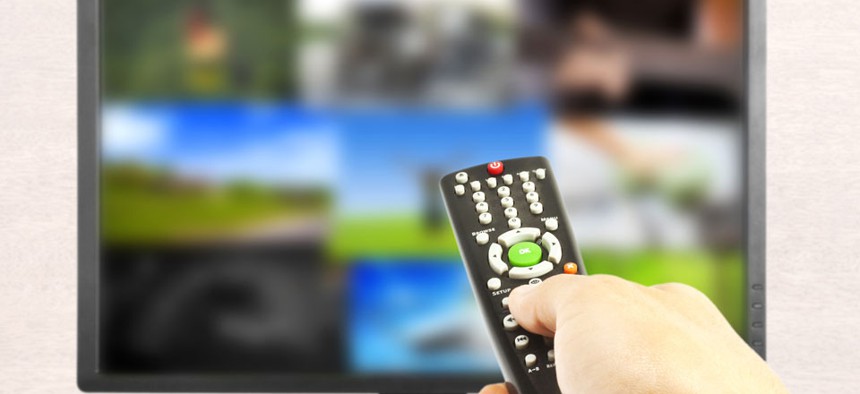Your TV Is Spying on You

Skylines/Shutterstock.com
The campaign strategy that married elections to big data is now being applied to your home theater.
Political messaging is moving back to the living room.
After an election in which Internet tactics seemed to captivate the public, political strategists are turning—or perhaps more accurately, returning—their attention to television advertising. TV isn’t sexy. Or at least, it hasn’t been lately. But with coming developments in user tracking and Internet-ready appliances, that’s going to change.
Even as more people ditch their traditional set-top boxes for online options like Netflix, Americans are actually watching more TV than they used to. In 2012, the average household spent 2 hours and 50 minutes consuming television, up 5 minutes from the previous year.
Quality content is partly behind the surge. So is our growing appetite for binge-watching. But, as Netflix’s famous gamble with House of Cards revealed, it’s behavioral data that has the biggest potential to keep our eyes glued to the screen. As a result, just as Web-browsing data came to the aid of political campaigns in the last electoral cycle, so will our television-watching habits in the next.
“There's going to be a marriage of the digital and the television, and that's going to be the future,” Republican strategist Sara Fagen told an audience at a conservative conference earlier this month. “That's where Republicans have an opportunity not just to catch the Democrats, but to leapfrog them.”
Current technology can determine how many people on Netflix skip the credits, replay sex scenes, or abandon episodes of Mad Men midway through. That information provides a general idea of people’s activities on the service. But it’s more of a proxy than anything else. It can’t tell you, for example, whether a viewer hit the pause button out of diminishing interest or because they needed more popcorn.
There’s a simple way to fix this, Fagen thinks, and it’s called Microsoft Kinect—the motion-activated video-game controller for Xbox. Fans of Kinect have hacked the device to accomplish all sorts of incredible things, so why not mash together its facial-recognition and motion-sensing abilities with a Netflix-like data-gathering operation?
What you'd wind up with, probably, is a pretty impressive viewer-feedback system. With it, you might learn whether your target was in the room the moment your ad aired. You might even be able to find out if they were actually watching, or if they were distracted and had their head turned away from the screen.
The first problem with this technology is that it’s obviously creepy. Then again, consumers put up with a lot of commercial behavior-tracking already; this might eventually become another extension of it.
Actually getting online databases to talk to real-world sensors will be another challenge. Such a merger of detection technology won’t be ready in time for 2014, or even for 2016. Progressive strategists, such as AFL-CIO’s Michael Podhorzer, agree. But perhaps by 2020, something like it might exist, Fagen said. It all depends on how quickly America adopts The Internet of Things .
Central to that future are mobile devices, which will allow people to control their thermostats, locks, refrigerators, and other appliances over the Web. Political advertisers are salivating over the idea, because it provides even more opportunities to talk to voters.
“People are always on the move, and they're consuming their media in many places and in many contexts,” said Podhorzer, a cofounder of the Analyst Institute. “During the days of broadcast media, you could put an ad on TV and be pretty sure that most people would see it. Now, you have to do a very multilayered approach that makes sure that not only are you reaching each voter you care about, but you're reaching them in multiple ways.”
This revelation has spurred some interesting experiments. Remember Lucas Baiano, the twenty-something ad maker behind all those political commercials that looked like movie trailers? Working with Sen. Mitch McConnell, R-Ky., Baiano recently designed an ad campaign that targeted the mobile devices of people within a 5-mile radius of the Kentucky Derby—a brilliant tactic. Targeting a particular demographic only gets you so close to the voter you're looking for. Add in a specific time and place where you know your targets will be, and you may as well be standing right next to them.
"Having a streamlined and linked system as a tool will only improve accuracy in political marketing," Baiano told me by email. "[Fagen] isn't too far off with her prediction."
Carrying on sustained conversations with voters over time yields far greater benefits to a campaign than a single interaction does. To maintain that kind of relationship with someone as they shift from tablet to phone to laptop and back again, campaigners need to be able to associate all three devices with the same owner, according to Scott Foernsler, a marketing executive at ValueClick.
Bringing digital strategy to TV advertising marks the first step of that process.
“You’ve got to talk to people the way they live,” Foernsler said.
(Image via Skylines/Shutterstock.com)
NEXT STORY: Your essential catch-up of the week's news





